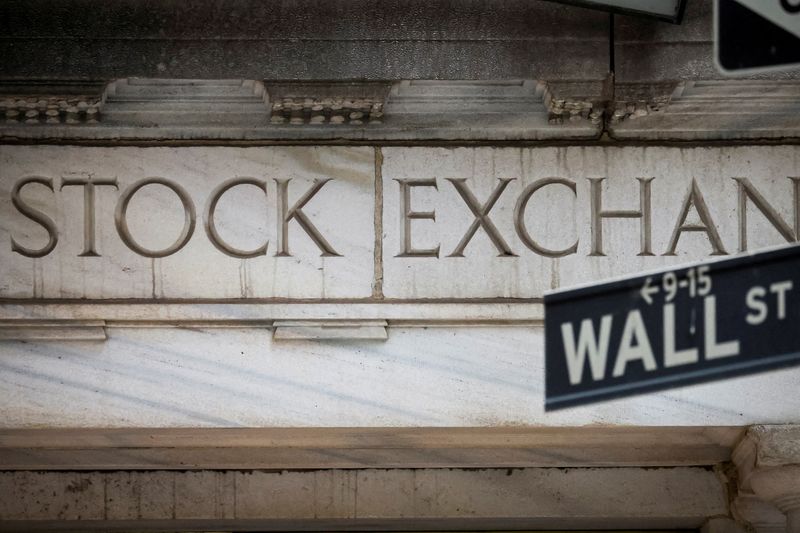By Lewis Krauskopf, Saqib Iqbal Ahmed and Laura Matthews
NEW YORK (Reuters) - The calm that has prevailed in the U.S. equity market may be starting to snap, as a range of worries bolster the case for investors looking to take profits on a rally that has seen the S&P 500 gain more than 7% this year.
For weeks, U.S. stocks have edged higher while measures of market volatility slid, despite concerns including uncertainty over the health of regional banks, a nearing deadline to raise the U.S. debt ceiling and worries over the impact of the Federal Reserve's aggressive monetary policy.
Though stocks remain near their 2023 highs, some investors now believe those factors will soon start taking a greater toll, limiting further upside. Front and center are concerns over regional banks, whose shares fell again on Tuesday despite a weekend auction that found a buyer for troubled First Republic Bank (NYSE:FRC).
The market may be "back in the soup on the banking crisis," said Chuck Carlson, chief executive officer at Horizon Investment Services. "I think that is what jolted the market out of its low volatility environment."
The S&P 500 fell 1.2% on Tuesday while the Cboe Volatility Index, known as Wall Street’s fear gauge, jumped after logging its lowest close since November 2021 on Friday.
Meanwhile, worries over a potential U.S. default have intensified after the Treasury warned on Monday that the government could run short of cash to pay its bills by June.
And while investors expect the Fed to signal a pause in its monetary policy tightening after raising rates once more on Wednesday, many worry the impact of accumulated rate increases will create more ructions throughout the economy.
With weakness in regional banks and worries over a U.S. default adding near-term pressure, "things could get a little choppy in the near term," said Seth Hickle, derivatives portfolio manager at Innovative Portfolios.
Hickle believes investors with shorter time horizons should lighten up on stocks and raise cash allocations. Carlson, of Horizon Investment Services, said his firm's portfolios have lower-than-typical levels of equity exposure, instead holding money market funds and short-term bonds.
"It’s hard for us to come up with a scenario where the market upside is much greater than 3% to 5% from current levels," Keith Lerner, co-chief investment officer at Truist Advisory Services, wrote in a note on Tuesday.
UNEASY CALM
The gyrations have disturbed a placid period in equities, which over the last week have been helped by better-than-expected earnings for several technology and growth stocks.
April included two weeks without a single daily move of at least 1% in either direction for the S&P 500, according to Willie Delwiche, investment strategist at Hi Mount Research. Over the prior 16 months, there had only been one such week for the benchmark stock index, Delwiche said.
Many investors don’t expect that calm to continue, as a battle over raising the $34 trillion U.S. debt ceiling looms.
Treasury Secretary Janet Yellen warned on Monday that the agency will be unlikely to meet all U.S. government payment obligations "potentially as early as June 1" without action by Congress.
Matthew Tym, head of equity derivatives trading at Cantor Fitzgerald, said some investors on Tuesday were taking options positions designed to protect their portfolios in June and July, a period where many believe equities could be vulnerable to debt-ceiling related volatility.
"People are terribly under-hedged," said Tym, who has been recommending portfolio options hedges in major exchange-traded funds.
EYES ON THE FED
Much depends on the message Fed Chairman Jerome Powell delivers at the end of Wednesday’s monetary policy meeting.
Futures markets positioning showed investors pricing in an 87% chance that the Fed will raise rates by 25 basis points on Wednesday, according to the CME FedWatch Tool, followed by cuts later in the year - though policymakers have projected borrowing costs remaining at around current levels until year-end.

If investors are right, markets may be in for more gains. In the six rate-hiking cycles since 1984, the S&P 500 has posted an average three-month return of 8% following the peak funds rate, Goldman Sachs (NYSE:GS) strategists wrote.
However, the S&P 500 is already trading well above its valuation at the end of any cycle except the one ending in 2000, when the S&P 500 declined despite a Fed pause, the bank said. Goldman has a year-end target of 4,000 for the index, about 3% below Tuesday's close.